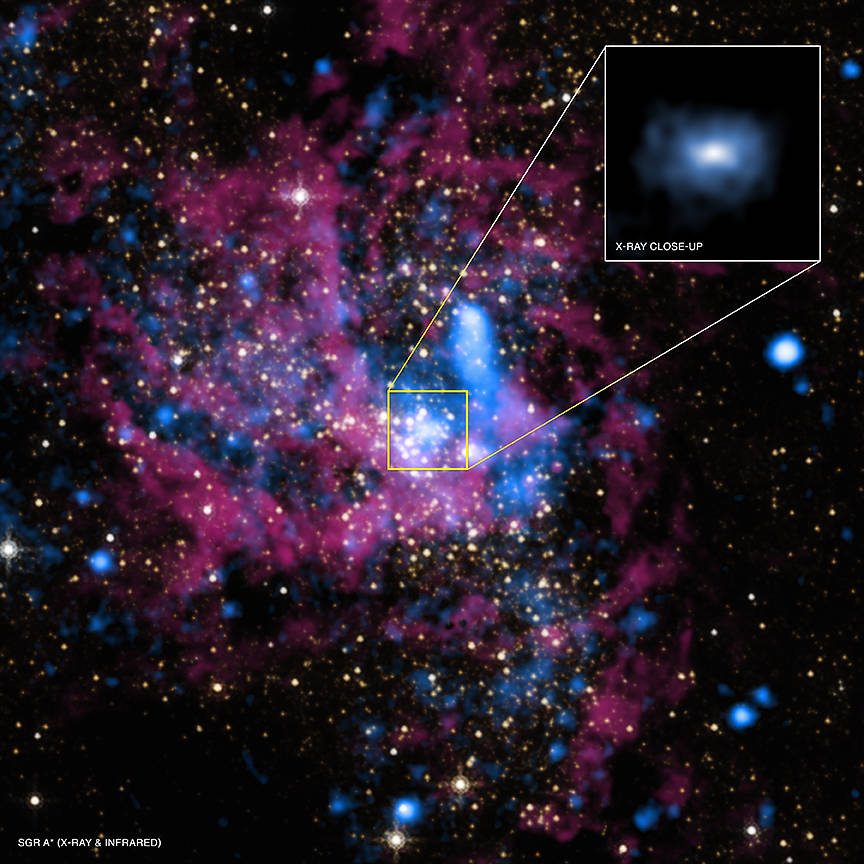Astrophysicists set out to study supermassive black holes, the close relatives of Sagittarius A*, meandering throughout our galaxy.
The mysterious galactic objects known as black holes help astrophysicists test the equations of general relativity and take a peek inside the dark world.
You might think black holes take up some distant corner of the universe, but we don’t have to look very far to find black holes.
There’s at least one behemoth black hole lurking in the Milky Way’s center. As you may know, it goes by the name Sagittarius A* or Sgr A* for short.
A constructed image from the Hubble telescope’s infrared, and from Chandra’s Observatory X-rays gives us our best look at Sgr A*’s location. Check it out in the image above.
Incredibly, as it turns out, Sagittarius A* isn’t alone in our galaxy.
There’s now cumulative evidence suggesting that The Milky Way is riddled with rogue black holes of different sizes.
How Many Black Holes are in The Milky Way?
Discovered in 1974, Sgr A* is a supermassive black hole (SBH) 4 million times greater in mass than the Sun.
Astrophysicists have long suspected that Sgr A* wasn’t the only black hole at the galaxy’s core but they couldn’t prove it.
However, as highlighted by the first detection of gravitational waves in 2015, scientists have made significant progress in the search for black holes in just the last couple of years.
Last year, researchers from Keio University (Japan) found evidence of what they think is an intermediate-mass black hole (IMBH) candidate in the galactic center. IMBH sizes come in between supermassive black holes (SBHs) and the smallest of black holes, stellar-mass black holes (SMBHs).
Then, just about three weeks ago, another research team at Columbia University detected the galactic footprint of a dozen black holes in The Milky Way’s center.
The team detected dozens of X-ray sources, and after ruling out those from cosmic objects known as millisecond pulsars, they identified 13 black holes.
They also estimate there could be over 10,000 black holes swirling around the area.
Some of these black holes (300-500) are binary systems orbited by stars in the immediate vicinity of Sagittarius A*, and up to 10,000 isolated black holes, with no orbiting stars, scattered around the center of the galaxy.
Rogue Supermassive Black Holes Roaming our Galaxy
Recently, we’ve learned that the Sun, and other stars, could have galactic siblings with which they share their stellar DNA.
Now, a new international study from Yale University, the University of Washington, University College London, and Institut d’Astrophysique de Paris suggests that Sagittarius A* may have a few fellow SMBHs in its neighborhood.
Astronomers then used Romulus, a cosmological modeling software, to study SMBHs’ theoretical tendency to merge together and to simulate the movements of supermassive black holes.
SMBHs were thought to exist only at the core of galaxies like The Milky Way, but now there’s evidence suggesting they might also roam around the galactic outskirts, far from the center.
Could these rogue galactic beasts get near our Sun and pose a potential threat? Researchers say this is “extremely unlikely” to happen.
“We estimate that a close approach of one of these wanderers that is able to affect our solar system should occur every 100 billion years or so, or nearly 10 times the age of the universe.”



















Comments (0)
Most Recent